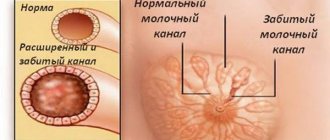Much has been written about how to properly attach a baby to the breast. Mothers often rely on materials and videos on the Internet. However, I often hear on the phone that “our attachment is correct, but for some reason it hurts” or “it hangs on the chest, but adds little.” In fact, it turns out that the attachment needs to be corrected and then “suddenly” - feeding does not hurt, the baby’s weight begins to grow much faster, painful lumps in the breast stop appearing, and the mother (shhh!) begins to enjoy breastfeeding.
I want to delve into the topic as a practitioner and share my observations. Perhaps my notes will help you avoid problems with feeding.
From the article you will learn:
Correct attachment to the breast can be checked by these signs:
1. The child’s lips are at an obtuse angle: 120-150 degrees. The muscles around the baby's lips should be relaxed. Tense lips, elongated like a tube, even if they are turned out “like a fish” - a sign of poor attachment.
2. The baby's lower lip is turned outward.
3. With good attachment, the lower lip and chin sink into the chest. (Like the first photo). That is, to see signs 1-2, you need to move your chest away (as in the second photo). This means that the baby is well pressed to the mother’s body!
4. The baby’s mouth is wide open, that is, the lower jaw is well retracted.
5. You see how almost all facial muscles work from the chin to the temple.
6. At the same time, the child does not retract his cheeks.
7. The baby’s tongue lies on the lower gum. If you bend your lower lip, you should be able to see how it works.
8. There are no clicking or smacking sounds when feeding. These sounds indicate the destruction of the vacuum. This means that it is difficult for the baby to hold the breast.
9. After feeding, your nipple is not deformed, the top resembles a bowler hat. If it is beveled, flattened, with a “ridge”, then something wrong is happening to it in the mouth.
10. It does NOT hurt to feed. Painful sensations can only occur during suction, for a few seconds, but do not increase during feeding.
If everything is as in these 10 points, you succeeded in breastfeeding perfectly!
ATTENTION! Some of these signs may not be achievable if the baby has anatomical features, such as a short frenulum. The muscles and other structures involved in sucking may become spasms as a result of childbirth or during the prenatal period, which will also affect sucking. Regarding the frenulum, you need to consult a dental surgeon, and an osteopath can loosen the clamps.
And I don’t recommend using the areola as a guide: all or not all of it should be in the child’s mouth, depending on its size! A small areola can be completely in the mouth, but the attachment will still not be correct! Often the breastfeeding is very good, but a large areola is visible above the upper lip and sometimes below.
Correct attachment to the breast
The article you are reading now is the most popular on our site. And this is no coincidence! After all, effective latching of a baby to the breast is the basis of breastfeeding.
A lot depends on the success of latching: whether you can breastfeed painlessly, whether your breasts will empty well, and even how much weight your baby will gain. Effective breastfeeding is the key point that can prevent many troubles.
Here are the most common problems that can arise due to improper application:
- pain during feeding, abrasions and cracked nipples;
- slow weight gain in a child;
- insufficient breast stimulation – and therefore insufficient milk production;
- the child “hangs” on the chest, he has to make more efforts to eat;
- Due to ineffective breast emptying, milk stagnation (lactostasis) may occur.
If you see familiar difficulties in this list, don’t rush to run for formula, but check to see if your baby is latching on well ?
So, how can you determine if your baby is attached to the breast correctly?
- the child's mouth is open as wide as possible;
- the breast is deep in the baby's mouth;
- the child’s chin touches the chest tightly, as if leaning on it;
- application is asymmetrical: if the areola is large, then it is visible from above, but almost not from below;
- the baby’s lips are relaxed (and may even be slightly turned outward);
- the cheeks are round and do not retract when sucking;
- the mother’s breast also takes on a rounded shape, without stretching under the weight of the baby’s head;
- There are no extraneous sounds during feeding (smacking, clicking, etc.)
If you see that your baby is latching onto the breast incorrectly, or it hurts you to attach him to the breast, try reattaching him using small tips. Five steps to effective application:
- To begin, take a comfortable, stable position in which you can comfortably feed your baby even for a long time. You can use any furniture, ottomans and pillows that will help you get comfortable.
- It is best to start latching when the baby is no longer sleeping (or just starting to wake up), but is not yet crying.
- Place your child as close to you as possible. Hold it so that your shoulders, back and hip are in the same line and your belly is pressed against your stomach. Thanks to your support, the baby will be in a stable position and will be able to easily tilt his head back (to do this, do not press or put pressure on the back of his head).
- At the beginning of feeding, your nipple is at the level of the baby's nose. Touch it to the area above the upper lip, and the baby will instinctively throw back his head and open his mouth wide. At this moment, gently and smoothly pull the child towards you so that the chin is pressed to the chest. When applying asymmetrically, the lower lip should be located as far from the nipple as possible, while the upper lip can be directly above or above the nipple.
- To help your baby, you can support your breast with your hand while you latch on. For example, place your thumb about 5 cm above the nipple, leave the rest of your fingers below and squeeze the breast slightly. Make sure that when latching onto the breast, the baby does not bump his lips against your fingers (even if you manage to pull them away at the last moment, you will not be able to support the breast).
Don't worry if you can't attach your baby right away.
Sometimes it may take several attempts, sometimes you need the help of another experienced mother or specialist who will help you put theoretical knowledge into practice.
But in the end, a successful result is guaranteed! Call a consultant Do you have any questions? +7 (812) 956-3-954
Where does proper breastfeeding begin?
Many materials that tell and show how to attach a baby to the breast miss an important detail.
Correct attachment depends on how you hold your baby in your arms! It depends on how your body is positioned, and on how your baby sits on it!
It all starts with the position that the mother chooses for feeding. Look at the picture. This is a slide from a lecture I gave in 2015 at the School of Mothers at Polyclinic No. 2 (why should I waste it?!)
The mother in the left picture clearly will not sit for more than 15 minutes, as was recommended in the second half of the 20th century. The second will be able to feed as much as the baby needs, enjoying and relaxing.
The first mother's baby's body rests on her knee, which required additional support. He is pressed sideways to his mother's body and is forced to strain (try drinking with your head turned?!). The picture shows a blunt angle of the child’s lips - this is the “wrong” grip! He will receive milk at high tide, when under the influence of oxytocin it itself runs into the mouth. But will this be enough?
The position of the mother in the second picture is also far from the classic models offered, for example, by WHO. This is a free interpretation of the situation that consultants call the “Cradle”, with a tangible influence of “relaxed feeding” that came from the West. But it will be much easier for the baby to grab the breast correctly and get something out of it after the hot flush!
The second “modern” picture contains the basic rules for successful latching of a baby:
1. First, the mother should take a comfortable position that will provide relaxation and strengthen the oxytocin reflex.
2. The child rests on her body: with his pelvis, stomach, chest, his chin sinks into her chest.
3. Support along the child’s back from the base of the skull to the sacrum (or lower back, if the baby is older). Mom seems to straighten his back between her body and her hand. If the back is straight, the baby automatically lifts his chin slightly and throws his head back. Now he can well move his lower jaw down, grab the chest deeply and hold it in this position without Herculean efforts!
4. The back of the baby's head should always be free. Even 1 finger on the back of the head limits head movements and spoils the grip!
Although we discussed above the feeding position, which is commonly called a “cradle,” these rules will help you correctly attach your baby in other positions: lying on your side, under your arm, and any others.
Be careful: If the baby is turned sideways to his mother, he becomes very tense and tired. No matter how hard mom tries to place her breast deeply on him, over time he will slide onto the nipple. Even if the baby is pressed against his stomach and the pelvis is half-extended, this can affect the attachment! In a “twisted” position, the baby will need more effort to hold and suck the breast.
If the baby curls up in a C shape at the chest and dives his nose into it, he will not be able to move his jaw for a good latch.
The baby is an active participant in breastfeeding; he does not need to be “put on” the breast! He needs to create conditions so that he himself gets along with her in the best possible way!
Center for Professional Support of Motherhood and Childhood
Proper attachment to the breast and a comfortable position when feeding will avoid many problems and complications with the breast. The breast is placed in a wide open mouth, so that the nipple is as deep as possible, and the breast is grasped more from below than from above.
photo
If you feed your baby while sitting, you can follow simple recommendations.
In order to comfortably and correctly attach the baby to the breast, the mother holds his head, placing the index and thumb behind the ears (fingers form the letter “C”)
and the chest is supported by the hand in the shape of the letter “C”, with the thumb on top and the other four fingers below. The fingers are at a sufficient distance from the areola so as not to limit the grip and form a fold of the tissue of the areola and nipple.
Sitting comfortably in one of the feeding positions, the mother positions the baby's head so that the nose is opposite the nipple. The mother stimulates the child to develop a search reflex (squeezes a few drops of milk into the baby’s mouth, touches the baby’s lips and cheeks with her chest), while the baby should open his mouth wide. At this moment, the mother brings the baby’s head closer to the breast and at the same time inserts the breast, lightly pressing the fold of the breast on the baby’s lower jaw. In this case, it is important that more areola tissue gets into the baby’s mouth, and the areola is captured more from below than from above (asymmetrical capture). After the baby begins to suck, it is necessary to evaluate the correctness of attachment to the breast by external signs:
- Painless sucking (if the mother experiences pain during sucking, it is necessary to pick up the breast by inserting the little finger into the corner of the baby’s mouth and try to attach the baby again)
- The child's jaws are positioned at an obtuse angle
- Lips turned outward
- The tongue lies on the lower jaw (often visible in the corner of the mouth)
- The baby’s chin, and often the nose, touches the chest
- The baby is actively sucking, you can hear him swallowing
Photo
Incorrect attachment of the baby to the breast leads to
- Painful sensations, nipple injuries, stagnation of milk in the breast, inflammation of the mammary glands
- Need to restrict feeding due to pain
- Restlessness and rapid fatigue of the baby at the breast, insufficient volume of sucked milk
IMPORTANT! The formation of skills in proper sucking, holding the breast in the mouth, and behavior at the breast occurs during the first two months of a child’s life. This is the child's first education, often requiring patience and calm persistence from the mother. Often the baby is unable to effectively latch on and suckle at the breast in the first days of life. Sometimes it takes several tries before he succeeds.
The use of a pacifier and other objects for sucking in a child under 2 months interferes with the formation of correct breastfeeding skills, up to and including refusal of the breast.
The article was created within the framework of the project “Breastfeeding - a healthy start in life” with the support of the Presidential Grants Fund of the President of the Russian Federation.
Signs of proper attachment
- the child has captured the nipple and most of the areola (2-3 cm from the nipple);
- the lips (especially the lower one) are everted;
- mouth wide open;
- the chin is pressed to the chest, the tip of the nose can touch it;
- no extraneous sounds are heard during sucking (only swallowing);
- it doesn't hurt mom.
If during feeding you hear extraneous sounds (clicking, smacking, whistling), it means that either the baby has not latched correctly or he has a short frenulum of the tongue. In the latter case, it is worth consulting with a pediatric dentist, and if there really is a problem, then it is better to trim the frenulum (this happens quickly, bloodlessly and practically painlessly, and you can immediately put the baby to the breast).
Unpleasant sensations may occur when the baby has a shallow latch on the breast. If you feel discomfort, it is better to remove the breast and reinsert it. To carefully remove the breast, the main thing is to break the vacuum that has formed during the sucking process. To do this, you can insert your little finger into the corner of the child’s mouth, unclench the gums and quickly reach the breast.










